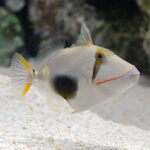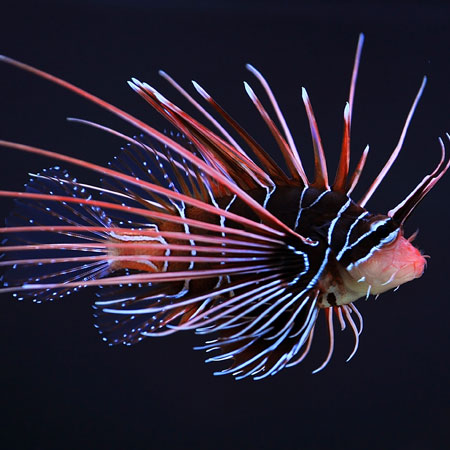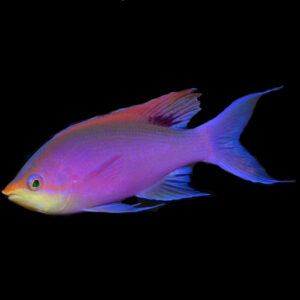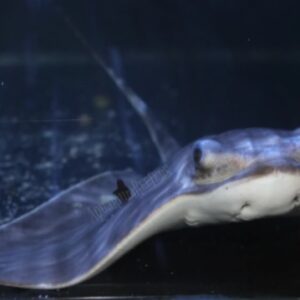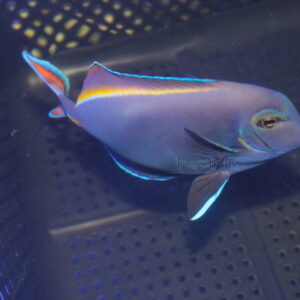Description
The Radiata Lionfish, scientifically known as Pterois radiata, is a visually stunning fish with a distinct appearance. It can grow up to a maximum size of approximately 8 inches (20 cm) in length. This species features long, feathery pectoral fins that extend outward, giving it a majestic and captivating presence. The body is adorned with vibrant stripes and patterns, usually consisting of red, brown, and white colouration, creating a mesmerizing display.
Taxonomy
Pterois radiata belongs to the genus Pterois, which is part of the family Scorpaenidae. The Scorpaenidae family includes various venomous fish species. The Radiata Lionfish shares its genus with other lionfish species, such as the Red Lionfish (Pterois volitans) and the Devil Firefish (Pterois miles). Its closest relatives are the other members within the same genus.
The scientific name, Pterois radiata, has an etymology rooted in Latin and Greek. “Pterois” translates to “feather” in Greek, referring to the species’ distinctive pectoral fins. “Radiata” means “radiating” in Latin, which may describe the striking patterns and stripes radiating from the body.
Natural Habitat
In its natural habitat, the Radiata Lionfish typically inhabits coral reefs and rocky areas. It seeks shelter among crevices, caves, and coral formations during the day. These environments provide the fish with suitable hiding spots to camouflage itself and wait for unsuspecting prey. The lionfish’s colours and patterns blend well with its surroundings, enhancing its chances of successful hunting.
Keeping the Radiata Lionfish Healthy:
Caring for the Radiata Lionfish requires attention to detail due to its specific needs. It is considered moderately challenging to care for this species. A well-maintained aquarium with stable water parameters is essential. The water temperature should be maintained between 75°F and 82°F (24°C to 28°C), and the pH level should be kept within a range of 8.1 to 8.4. Regular monitoring of water quality, proper filtration, and a spacious tank are crucial for the well-being of the fish.
Special Requirements and Feeding
The Radiata Lionfish is a carnivorous predator that primarily feeds on small fish and crustaceans in the wild. In an aquarium setting, it should be offered a varied diet consisting of meaty foods such as live or frozen shrimp, fish, and crustaceans. Feeding should occur regularly to ensure proper nutrition and growth. It is important to provide appropriately sized prey to prevent choking hazards and ensure the fish can easily consume its food.
How Many Should I Keep?
Due to their territorial nature, it is generally recommended to keep only one Radiata Lionfish in a tank unless you have a considerably large aquarium with ample hiding places. These lionfish may exhibit aggression towards conspecifics (members of the same species). Providing enough space and suitable hiding spots is crucial to minimize stress and aggression.
Hunting Method
The Radiata Lionfish employs an ambush hunting strategy. It patiently waits for prey to swim by, using its camouflaged appearance and extended pectoral fins to disguise itself among coral or rocky structures. When a suitable opportunity arises, it rapidly extends its mouth and engulfs the prey with its expandable stomach. This hunting method allows the lionfish to capture a wide range of small fish and invertebrates.
Lighting Preference
The Radiata Lionfish prefers moderate to low lighting conditions in the aquarium, simulating its natural habitat.
Suitable Tank Mates
When selecting tank mates for the Radiata Lionfish, caution must be exercised. They may view smaller fish as potential prey, leading to aggression or predation. It is advisable to choose tank mates that are larger and too large to be considered prey. Compatible tank mates may include other larger predatory fish, such as groupers or larger angelfish. However, it is essential to monitor their behaviour closely to ensure compatibility and minimize aggression within the tank.
Reproduction in the Wild
The Radiata Lionfish, scientifically known as Pterois radiata, reproduces through a process called spawning in the wild. Spawning refers to the release of eggs and sperm into the water column, where fertilization occurs externally. Lionfish, including the Radiata Lionfish, court by engaging in a spiralling courtship dance.
Breeding Pterois radiata:
Breeding the Radiata Lionfish in captivity can be a challenging but rewarding endeavour. Here is a detailed overview of the breeding process:
- Set up
To initiate breeding, a separate breeding tank should be prepared. The tank should provide suitable hiding places and structures for the fish to lay their eggs and for the subsequent protection of the eggs and fry. Monitoring and maintaining optimal water quality parameters, including temperature, salinity, pH, and filtration, are essential for successful breeding.
- Courtship/Spawning
The courtship and spawning behaviours of the Radiata Lionfish typically involve intricate displays and rituals. The male lionfish initiates courtship by displaying vibrant colours and erecting its fins to attract the female’s attention. Once the female is receptive, the pair engages in synchronized swimming and spiralling movements.
During spawning, the female releases a mass of eggs into the water, while the male simultaneously releases a cloud of sperm to fertilize the eggs. Fertilization occurs externally, and the buoyant eggs rise towards the water’s surface.
- Rearing
After successful fertilization, the eggs float near the water’s surface, forming a gelatinous mass. Maintaining optimal water conditions during this period is crucial for the survival and development of the eggs. The eggs typically hatch within 48 to 72 hours, depending on water temperature.
Upon hatching, the fry, known as larvae, have a yolk sac for nourishment and are transparent in appearance. They gradually develop and start exhibiting characteristics resembling miniature adult lionfish. Providing suitable food sizes and proper feeding techniques are essential during the rearing process to ensure the healthy growth and survival of the fry.
Sexual Dimorphism
Sexual dimorphism in the Radiata Lionfish is not easily discernible based on external characteristics alone. Males and females generally have similar appearances, displaying the species’ characteristic vibrant colours and patterns. Further internal examination or DNA testing may be required to determine the sex of individual lionfish.
Distribution
The Radiata Lionfish, Pterois radiata, is naturally found in the Indo-Pacific region. While there may be captive-bred or line-bred strains of the Radiata Lionfish available in the aquarium trade, the original wild fish originates from the Indo-Pacific area.
Summary
The Radiata Lionfish, scientifically known as Pterois radiata, showcases fascinating reproductive behaviours in the wild and can be bred in captivity with proper care and attention. Through courtship rituals, spawning, and subsequent care for the eggs and fry, the breeding process can be a rewarding experience. Setting up a suitable breeding tank, monitoring water conditions, and providing appropriate feeding and care are essential for successful breeding. The Radiata Lionfish’s unique appearance and behaviours make it an intriguing species to observe and keep in aquariums.
The Fish pictured here are representative only and the livestock you receive may vary in pattern, coloration, and shape.


